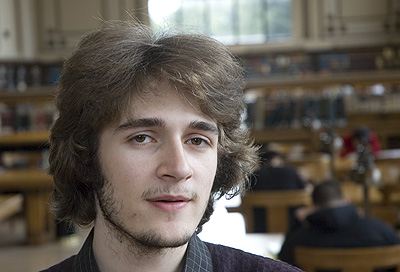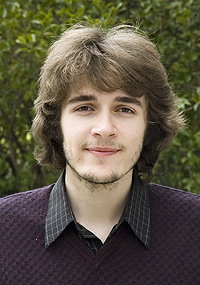UC Berkeley Web Feature
 |
University Medal finalist Alexis Ashot in Doe Library. (Wendy Edelstein photos) |
Alexis Ashot is not just a polyglot art-history major, he's a true Renaissance man
BERKELEY – There's an air about University Medalist finalist and history of art major Alexis Ashot that recalls someone from an earlier, more genteel era, and it's more than his wispy beard and abundant wavy hair. Not only does Ashot bear an uncanny resemblance to Daniel Radcliffe (the actor who portrays the wizardly Harry Potter), but his demeanor also seems to belong to a simpler time, one when chivalry and courtesy were the rule rather than the exception, and scholarly passion was more commonplace.
Ashot's intellectual interests are the product of both nature and nurture. Born at the UC San Francisco hospital — "I have a long affiliation with the University of California," he jokes — Ashot and his family moved to South Pasadena when he was 12. His father is a painter, and his mother is a writer, translator, and poet who inspired her son to master other languages, starting with reading and translating French comic books to him when he was a child.
Today Ashot speaks Russian and French fluently, has an excellent grasp of German, and is studying Italian. "I like French but in many ways I feel a more natural knack for German, because the idiom and vocabulary are an amazing archaic mirror of English," he explains, adding with enthusiasm: "It's completely Tolkienian and cool to say German things and think of their relationship to words in English, Russian, and French."
 'When a society chooses to make art a priority, it makes a more tangible legacy for those future generations than even the material benefits we accumulate.' -Alexis Ashot |
Ashot came to his major serendipitously. On the advice of "a very wise, perceptive friend," who urged him to sample the history of art department's offerings, Ashot signed up for two courses his first semester: 19th-century French Art, and Hellenistic Art and Architecture. (He also has a longstanding interest in ancient Greece and Greek mythology.) Both were intended for upper-division students, but "I wanted to see what history of art is like once you're in it, not when you're doing introductory work," he explains. He is glad he chose the two classes so early in his UC Berkeley career, because "they were completely geared toward convincing me that this is what I wanted to do."
And yet his ultimate choice of major "came as something of a shock" to him, since he had been considering literature, history, languages, even science and math. In the end, he decided that art history ties many of those seemingly disparate threads together: "It touches on everything, yet it is deeply personal and really speaks to what lies at the core of humanity," he explains.
Andrew Stewart, the professor who taught Hellenistic Art and Architecture to the freshman Ashot, confirms that his student found the right calling: "I have been an undergraduate major adviser in this department, on and off, for 27 years, and have never seen anything like this level of achievement before," Stewart enthused in his letter recommending Ashot for the Medal. "He walks on water."
Stewart lauded Ashot's 3.994 GPA (a perfect record besmirched only by a B- in a one-credit physical education class) and his "elegant and vivid" writing style. He singled out a remarkable discovery Ashot made during "Hands on at the Hearst," a museum seminar Stewart taught Ashot's sophomore year: Ashot was researching a Roman bust once believed to depict Marcus Aurelius at the campus's Phoebe A. Hearst Museum of Anthropology, when he discovered that the object's provenance, date, and identification — established by two University of California professors and leading experts in the field in the early 20th century — were wrong. His report now is part of the museum's curatorial files.
Ashot is most passionate when defending the relevance of his chosen discipline. "Art has a personal, immediate effect," he says. "Any given individual who looks at a painting or a sculpture, listens to Mozart's "Requiem," or reads Dante's "Inferno" feels joy and elation and a sense of being pulled up to a level they haven't experienced before."
Taking a wider-angled, historical view, he argues that "art is crucial to human survival" — vital to both the individual and to larger society — with a "transgenerational value that is bigger than its value for any one individual" and can transcend immediate concerns of self-interest and self-preservation. "When a society chooses to make art a priority, it makes a more tangible legacy for those future generations than even the material benefits we accumulate," he says. "It leaves both a record of previous generations and something to inspire the future."
 The
University Medal The
University MedalEstablished in 1871 by California Governor Henry Huntly Haight, the University Medal honors UC Berkeley's most distinguished graduating senior. Three to five students are also named as finalists. [an error occurred while processing this directive] |
While Ashot hasn't mapped out his own future beyond meeting his thesis deadline while he wraps up a full courseload, he's fairly certain his next step will be graduate school in history of art. Under the supervision of T.J. Clark, whose 19th Century French Art class was the other reason Ashot chose his major, Ashot is investigating how self-portraiture touches on "issues of the self and how understanding and presenting the self functioned in the Romantic period in the case of specific artists." He's concentrating particularly on the 19th-century painters Ingres and Delacroix.
When he was younger, Ashot dreamt of being a Renaissance man. He claims that he has since forsaken that goal, and his transcript is indeed chock-a-block full of courses in his major. His dedication has paid off: he received the Maybelle Toombs Award for Excellence in the History of Art, the departmental citation, and will be the history of art valedictorian this year (selected unanimously by that department's faculty).
But his résumé belies the transcript's suggestion that he's hewed only to one path: Ashot appeared as the young Igor Sikorsky, inventor of the helicopter, for the History Channel series "Man, Moment, Machine" last summer; has sung Russian choral music with an a-cappella ensemble; interned with Christie's Fine Arts Auctioneers; and is on the board of directors of a fine-arts game-design company, among myriad other activities. During his semester abroad at University College London last fall, he decided to try his hand at fencing, since the school had an excellent program. And he took up tennis last summer, though he claims to be a "much better swimmer than I am tennis player or fencer."
Asked what advice he would offer incoming freshmen, Ashot recommends that they embrace his own brand of enthusiastic eclecticism: "Explore everything you ever felt an impulse toward, or that connects with something from your childhood or adolescence, from your imaginings, or from the way you think you might want to go or the kind of person you might want to be," he urges. "And don't be afraid of taking courses that seem too advanced. It's always good to pull yourself up to a challenge."
Because who knows, he might have added — you could just find a mentor, or stumble upon your major.

